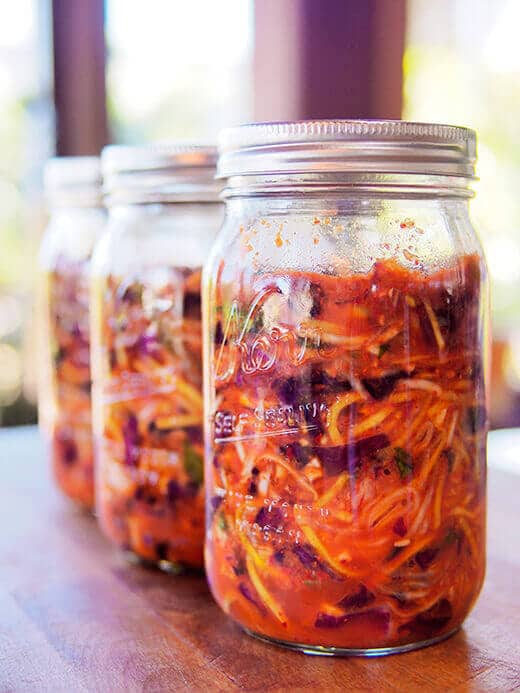Kimchi is one of those things that seems so exotic but is so ridiculously easy to make at home — and fresh, homemade kimchi is infinitely better tasting than anything you can buy from the market.
If you’ve never had this fermented side dish, think of it like a spicy Korean version of sauerkraut. The smoke and fire comes from gochugaru, a Korean red pepper powder (sometimes also called Korean chile flakes or Korean chili powder, but definitely not to be confused with American red pepper flakes or American chili powder).
Homemade kimchi is a pungent and complex blend of flavors owing to traditional spices (gochugaru, garlic and ginger) as well as a puree of Asian pear and yellow onion, which adds a subtle sweetness without the need for sugar. I use red cabbage for the same antioxidant benefits I get from my ruby kraut. (But you can also use the more traditional napa cabbage.)
Similar to kraut, kimchi is full of probiotic goodness and it’s not solely limited to Korean dishes. I’ve made kimchi omelets, kimchi quesadillas, kimchi pizza, and even spooned a heaping of kimchi on a baked potato. This version is a medium spicy that won’t burn your tongue off, but still has enough heat and tang to make a meal interesting.
Red Cabbage Kimchi
Makes 3 quarts
Ingredients
2 pounds red cabbage, chopped
1/4 cup pickling salt
1/2 pound daikon, julienned
1/2 pound carrot, julienned
6 green onions, sliced into 1-inch segments
4 cloves garlic, minced
1-inch piece fresh ginger, peeled and minced
1 small Asian pear (or apple), peeled, cored and chopped
1 small yellow onion, chopped
1 cup dechlorinated water
1/2 cup gochugaru (Korean red pepper powder)
2 tablespoons fish sauce
Making Your Red Cabbage Kimchi
Red cabbage tends to be a tad tougher than napa cabbage, so I chop mine into thin, bite-sized pieces.

In a very large bowl, massage the salt into the cabbage until the leaves start to release liquid.

Cover with water and let the cabbage sit at room temperature for at least two hours while the salt draws out moisture. Periodically toss the cabbage and work your hands through the leaves to expel more moisture.
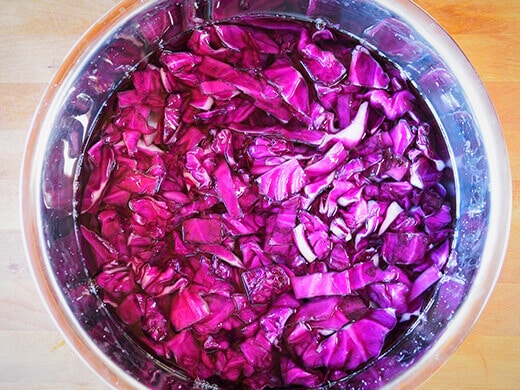
After about two hours, the cabbage should be soft and limp, and the volume reduced in half. (If yours is still firm and full, come back to it after another hour or two.)
Strain the cabbage and rinse under running water to remove excess salt.
Strain again, then return the cabbage to the bowl. Add daikon, carrot, green onions, garlic, and ginger.
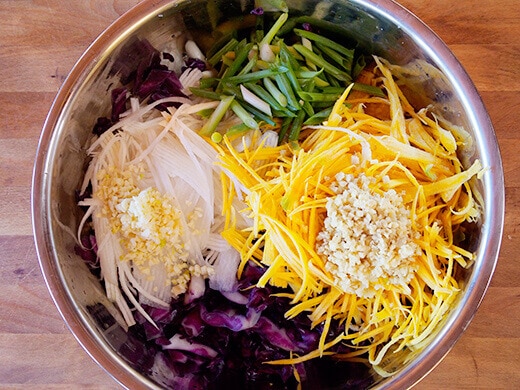
In a blender, combine the Asian pear (or apple, if using), yellow onion, water, gochugaru, and fish sauce, and give everything a whirl until smooth. Pour the sauce over the vegetables.
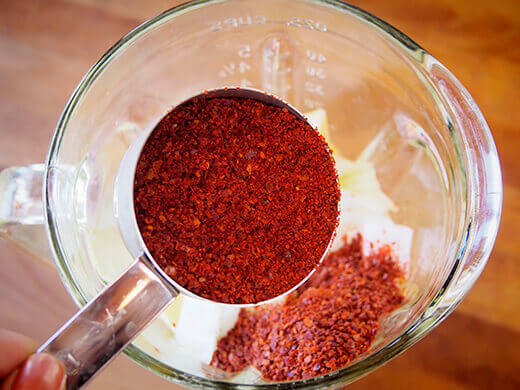
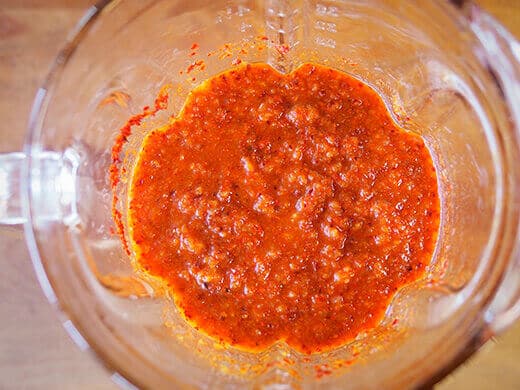
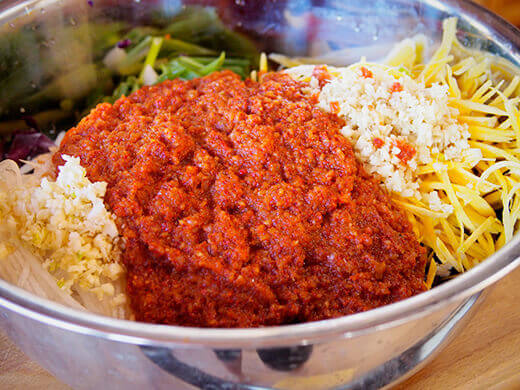
Now, don some gloves (the sauce can be pretty spicy and smelly to work with!) and give the kimchi a good rubdown, making sure the veggies are well combined and coated with sauce.
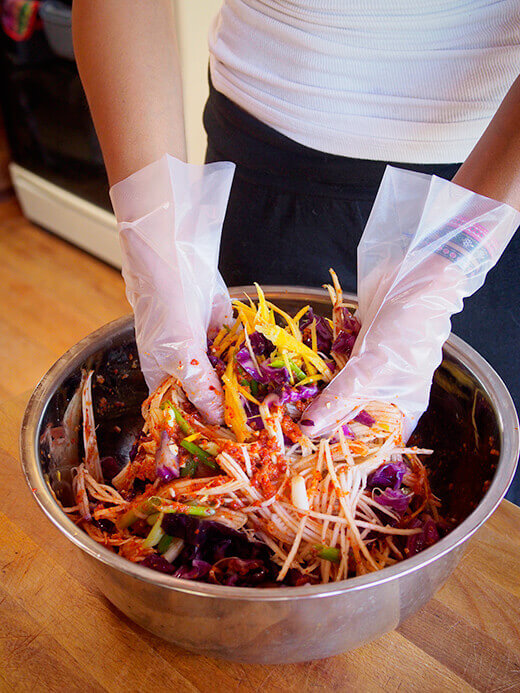
Pack the kimchi into jars, leaving 1 to 2 inches of headspace. The veggies will expand and release more liquid as they ferment, so you don’t want to overfill the jars.
Tamp down the veggies with the back of a spoon to fully submerge them. I find that there’s always enough liquid in the jars to keep them submerged, and since the liquid is more of a paste, the veggies don’t float to the top as in other ferments.

Wipe the rims clean, then loosely seal with lids and let the jars ferment at room temperature, out of direct sunlight, for at least three days. (It wouldn’t be a bad idea to place the jars in a shallow baking dish to catch any overflow of liquid.)
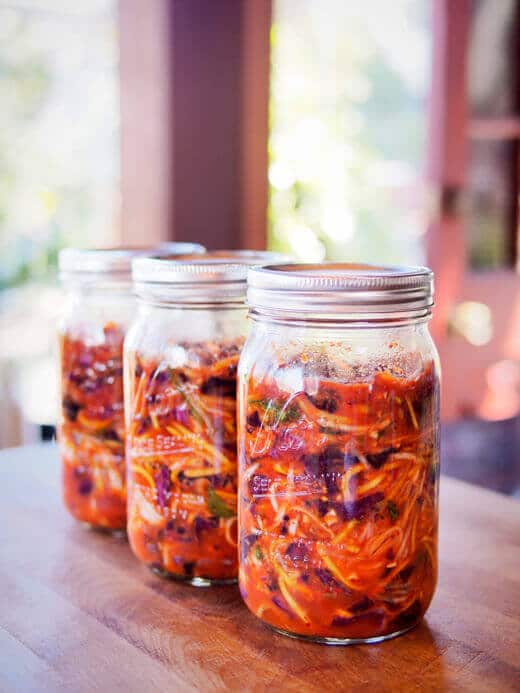
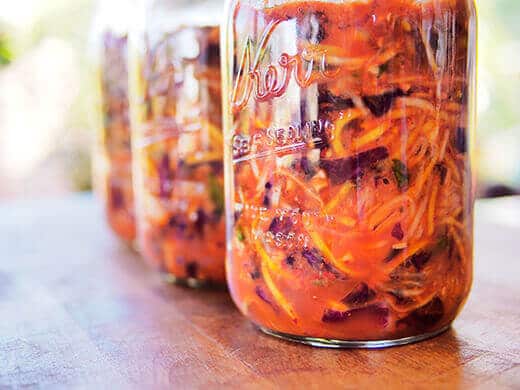
Every day, press down on the veggies with a spoon to expel more liquid and make sure everything is shipshape. A proper ferment should have no mold and no off smell.
After three days, you can start tasting the kimchi; refrigerate when the flavor has fermented to your liking. It should take on a spicy, sour taste. Some people like less sour and some like more sour, but you should definitely wait for your kimchi to take on a noticeably tangy taste if you want all the beneficial Lactobacilli in your ferment. I like to let mine brew for up to a week at room temperature for a more intense flavor.
Don’t worry if you feel that 3 quarts is too much kimchi for you to handle — let one of the jars get too sour in the fridge, and next month I’ll share one of my favorite Korean comfort food recipes that uses overly fermented kimchi!
Red Cabbage Kimchi

Homemade kimchi is a pungent and complex blend of flavors owing to traditional spices (gochugaru, garlic and ginger) as well as a puree of Asian pear and yellow onion, which adds a subtle sweetness without the need for sugar.
Ingredients
- 2 pounds red cabbage, chopped
- 1/4 cup pickling salt
- 1/2 pound daikon, julienned
- 1/2 pound carrot, julienned
- 6 green onions, sliced into 1-inch segments
- 4 cloves garlic, minced
- 1-inch piece fresh ginger, peeled and minced
- 1 small Asian pear (or apple), peeled, cored and chopped
- 1 small yellow onion, chopped
- 1 cup dechlorinated water
- 1/2 cup gochugaru (Korean red pepper powder)
- 2 tablespoons fish sauce
Instructions
- Chop Cabbage
In a very large bowl, massage the salt into the cabbage until the leaves start to release liquid.
Cover with water and let the cabbage sit at room temperature for at least two hours while the salt draws out moisture.
Periodically toss the cabbage and work your hands through the leaves to expel more moisture.
After about two hours, the cabbage should be soft and limp, and the volume reduced in half. (If yours is still firm and full, come back to it after another hour or two.)
Strain the cabbage and rinse under running water to remove excess salt.
Strain again, then return the cabbage to the bowl. Add daikon, carrot, green onions, garlic, and ginger.
In a blender, combine the Asian pear (or apple, if using), yellow onion, water, gochugaru, and fish sauce, and give everything a whirl until smooth. Pour the sauce over the vegetables.
Now, don some gloves (the sauce can be pretty spicy and smelly to work with!) and give the kimchi a good rubdown, making sure the veggies are well combined and coated with sauce.
Pack the kimchi into jars, leaving 1 to 2 inches of headspace. The veggies will expand and release more liquid as they ferment, so you don’t want to overfill the jars.
Tamp down the veggies with the back of a spoon to fully submerge them. I find that there’s always enough liquid in the jars to keep them submerged, and since the liquid is more of a paste, the veggies don’t float to the top as in other ferments.
Wipe the rims clean, then loosely seal with lids and let the jars ferment at room temperature, out of direct sunlight, for at least three days. (It wouldn’t be a bad idea to place the jars in a shallow baking dish to catch any overflow of liquid.)
Every day, press down on the veggies with a spoon to expel more liquid and make sure everything is shipshape. A proper ferment should have no mold and no off smell.
After three days, you can start tasting the kimchi; refrigerate when the flavor has fermented to your liking. It should take on a spicy, sour taste
Notes
Red cabbage tends to be a tad tougher than napa cabbage, so I chop mine into thin, bite-sized pieces. Don’t worry if you feel that 3 quarts is too much kimchi for you to handle — let one of the jars get too sour in the fridge.
Recommended Products
As an Amazon Associate and member of other affiliate programs, I earn from qualifying purchases.
-
Ball Mason 32 oz Wide Mouth Jars with Lids and Bands, Set of 12 Jars.
-
Organic Bamboo Cutting Board Set of 3 with Lifetime Replacements - Wood Cutting Board Set with Juice Groove - Wooden Chopping board Set for Kitchen, Meat and Cheese - Wooden Cutting Boards for Kitchen
-
ZWILLING Pro 7-inch Rocking Santoku Knife, 7'', Black/Stainless Steel
View the Web Story on red cabbage kimchi recipe.


